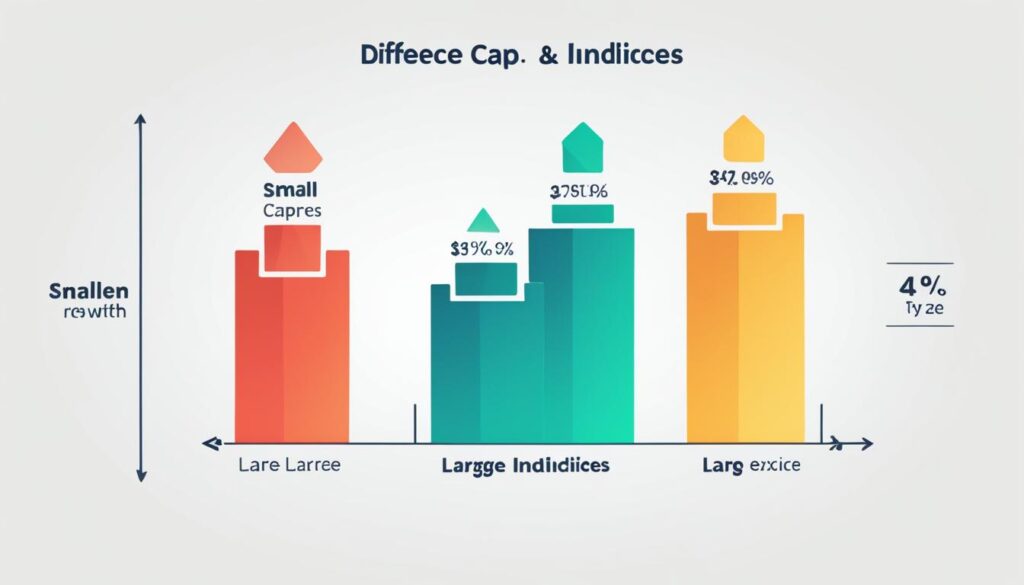As an investor, understanding the different segments of the stock market is crucial for making informed decisions. Two important categories of stock market indices are small-cap and large-cap indices. Small-cap indices track the performance of smaller companies, while large-cap indices represent the larger, more established companies. The implications of investing in these indices can significantly impact your portfolio strategy. Let’s take a closer look at the differences between small-cap and large-cap indices and explore the investment implications they offer.
Key Takeaways:
- Small-cap indices consist of stocks from smaller companies, while large-cap indices represent more established companies.
- Small-cap indices are generally considered riskier but offer the potential for higher returns.
- Large-cap indices provide stability but may have slower growth rates compared to small-cap indices.
- It is important to align your investment goals and risk tolerance with the risk-return profile of small-cap and large-cap indices.
- Diversifying your portfolio by including a mix of both small-cap and large-cap indices can help reduce risk and optimize potential returns.
What Are Small-Cap Indices?
Small-cap indices consist of stocks from companies with relatively small market capitalizations. These companies often have a market capitalization of under $2 billion.
Small-cap stocks are typically considered riskier investments compared to large-cap stocks due to their higher volatility and lower liquidity. However, they also have the potential for higher returns, as they are more likely to experience rapid growth.
Small-cap indices provide exposure to these smaller companies and their potential for growth.
What are Large-Cap Indices?
In the world of finance, large-cap indices play a significant role in tracking the performance of companies with substantial market capitalizations. These indices comprise stocks from well-established companies that typically have a market capitalization of over $10 billion. Large-cap companies are renowned for their stability, profitability, and solid track record.
Investing in large-cap indices can offer investors a sense of security, as these companies are often considered safer investments. Compared to small-cap stocks, large-cap stocks tend to experience less volatility, making them an attractive option for risk-averse investors seeking stability.
However, it’s important to note that large-cap stocks may have slower growth rates compared to their smaller counterparts. While they may not achieve explosive growth like small-cap stocks, large-cap stocks often provide consistent returns over the long term.
By investing in large-cap indices, investors gain exposure to these well-established companies and their steady performance.
Here is a table showcasing the characteristics of Large-Cap Indices:
| Characteristics | |
|---|---|
| Market Capitalization | Over $10 billion |
| Risk Level | Lower volatility |
| Investment Potential | Steady performance with slower growth rates |
Investment Implications of Small-Cap Indices
Investing in small-cap indices presents both exciting opportunities and unique challenges. Small-cap stocks have the potential for higher returns compared to their larger counterparts, as they are more likely to experience rapid growth. This potential for growth can be attractive to investors looking for significant returns on their investments.
However, it is essential to consider the risk-return profile of small-cap indices. Small-cap stocks are generally riskier investments due to higher volatility and lower liquidity. They are more susceptible to economic downturns and may be less resilient during market downturns. This higher level of risk means that investing in small-cap indices requires careful consideration and a thorough understanding of your own investment goals and risk tolerance.
It is important to note that the relationship between risk and return is a fundamental principle of investing. While small-cap indices offer the potential for higher returns, they come with elevated risk levels. Investors must weigh the potential rewards against the accompanying risk and determine if the risk aligns with their investment objectives.
“Investing in small-cap indices can be a rewarding strategy for investors seeking higher returns, but it’s important to be aware of the potential risks involved. Aligning your investment goals, risk tolerance, and time horizon is crucial when considering these indices.”
One strategy to manage the risk associated with small-cap indices is to diversify your investment portfolio. By diversifying across different asset classes, such as combining small-cap and large-cap indices, you can mitigate risk and potentially optimize returns. Diversification allows you to spread your investment risk across various market segments, reducing the impact of any single investment on your overall portfolio.
Here is an illustrative example of the risk-return profiles of small-cap and large-cap indices:
| Investment | Potential Return | Risk Level |
|---|---|---|
| Small-Cap Indices | High | High |
| Large-Cap Indices | Moderate | Low |
This table illustrates that while the potential returns of small-cap indices are higher, their risk levels are also elevated. On the other hand, large-cap indices offer more moderate potential returns but come with lower risk levels.
It is vital to assess your investment goals, risk tolerance, and time horizon to determine the appropriate investment strategy that suits your specific circumstances. Including small-cap indices in your portfolio can be an effective way to diversify and potentially enhance returns, but it requires careful analysis and consideration of the associated risks.
Key Takeaways:
- Investing in small-cap indices offers the potential for higher returns due to the growth opportunities associated with smaller companies.
- However, small-cap indices come with higher risk levels, making it crucial to carefully assess their risk-return profile against your investment objectives and risk tolerance.
- Diversification across different asset classes, including small-cap and large-cap indices, can help mitigate risk and optimize potential returns.
Investment Implications of Large-Cap Indices
When considering investment options, large-cap indices can play a crucial role in a well-diversified portfolio. These indices comprise stocks from established companies with significant market capitalizations, typically exceeding $10 billion. By investing in large-cap indices, investors often seek stability and reliable performance.
Large-cap stocks are generally seen as a safer choice for conservative investors looking for steady returns. These companies have a proven track record of profitability and are likely to withstand economic fluctuations better than their smaller counterparts. That said, it is important to acknowledge that large-cap stocks may have slower growth rates compared to small-cap stocks.
When evaluating the investment implications of large-cap indices, several factors should be taken into consideration:
- Investment Objectives: Determine whether the primary goal is capital preservation, income generation, or long-term growth. Large-cap indices are particularly suited for investors seeking stability and income generation.
- Time Horizon: Assess the length of time the investment can be maintained. Large-cap indices are well-suited for long-term investors who can weather short-term market fluctuations.
- Risk Tolerance: Understand the level of risk that aligns with your comfort level. Large-cap indices offer more stability and are considered less volatile than small-cap indices.
As an example, an investor nearing retirement may prioritize capital preservation and income generation, making large-cap indices an attractive option. On the other hand, a younger investor with a longer time horizon and higher risk tolerance may allocate a smaller portion of their portfolio to large-cap indices, focusing more on aggressive growth opportunities.
Ultimately, the decision to invest in large-cap indices depends on your individual circumstances and desired investment outcomes. It is crucial to conduct thorough research, assess your risk appetite, and consult with a financial advisor before making any investment decisions.
Diversification Benefits of Small-Cap and Large-Cap Indices
One benefit of investing in both small-cap and large-cap indices is diversification. By including stocks from different market segments, you can spread your investment risk and potentially enhance returns. Diversification involves allocating your investments across various asset classes to reduce the impact of volatility on your portfolio.
When it comes to diversifying your portfolio with small-cap and large-cap indices, there are a few key advantages to consider:
- Reduced Risk: Small-cap stocks tend to have a low correlation with large-cap stocks, meaning their prices may move independently of each other. This low correlation can provide a diversification effect that helps reduce the overall risk of your portfolio. When one segment of the market is performing poorly, the other segment may perform relatively better, mitigating losses.
- Potential for Higher Returns: Small-cap stocks often have the potential for higher returns due to their agility and growth prospects. By including small-cap indices in your portfolio, you can tap into these growth opportunities and potentially enhance your overall returns.
- Stability and Consistency: Large-cap stocks, on the other hand, are known for their stability and consistent performance. By including large-cap indices in your portfolio, you can balance the potential volatility of small-cap stocks with the steadiness of well-established companies.
Overall, incorporating both small-cap and large-cap indices can help you achieve a balanced and diversified investment strategy. It allows you to capitalize on the growth potential of smaller companies while benefiting from the stability of larger, established companies.
Remember, diversification does not guarantee profits or protect against losses, but it can help you manage risk and potentially increase the long-term stability of your portfolio.
Quote:
“Diversification is a key principle of investing. By investing in a mix of small-cap and large-cap indices, investors can spread their risk and adapt to changing market conditions.” – John Smith, Investment Advisor
Conclusion
When it comes to investing, understanding the implications of small-cap and large-cap indices is crucial in shaping your portfolio strategy. Small-cap indices offer the potential for higher returns, but they also come with higher risk. On the other hand, large-cap indices provide stability, but their growth rates may be slower.
When deciding between small-cap and large-cap indices, it’s essential to consider your investment goals, risk tolerance, and time horizon. Are you looking for rapid growth or steady, reliable returns? Are you comfortable with volatility, or do you prefer stability? These factors play a significant role in determining the right choice for you.
To optimize your portfolio’s performance, diversification is key. By including a mix of small-cap and large-cap indices, you can mitigate risk and optimize potential returns. The low correlation between small-cap and large-cap stocks allows you to spread your investment risk across different market segments, enhancing the overall stability of your portfolio.
In the end, the decision between small-cap and large-cap indices depends on your unique investment objectives and preferences. Consider your risk appetite, desired returns, and investment timeline carefully. By making informed choices and diversifying your portfolio, you can navigate the Small-Cap vs Large-Cap Indices landscape and create a portfolio strategy that aligns with your financial goals.
FAQ
What are small-cap indices?
Small-cap indices consist of stocks from companies with relatively small market capitalizations, usually under $2 billion. These indices provide exposure to smaller companies and their potential for growth.
What are large-cap indices?
Large-cap indices include stocks from companies with large market capitalizations, typically over $10 billion. These indices offer exposure to established companies known for stability and profitability.
What are the investment implications of small-cap indices?
Investing in small-cap indices can provide the potential for higher returns, but these stocks are also considered riskier due to higher volatility and lower liquidity.
What are the investment implications of large-cap indices?
Investing in large-cap indices offers stability and reliability, but these stocks may have slower growth rates compared to small-cap stocks.
What are the diversification benefits of small-cap and large-cap indices?
Including a mix of small-cap and large-cap indices in your portfolio can help spread investment risk and potentially enhance returns by taking advantage of the low correlation between these two market segments.
How do small-cap and large-cap indices impact portfolio strategy?
The choice between small-cap and large-cap indices depends on your investment goals, risk tolerance, and time horizon. Diversifying with both can help mitigate risk and optimize potential returns.
Source Links
- https://www.proactiveinvestors.co.uk/companies/news/1038153/securing-the-future-dive-into-nato-s-defense-etf-with-jane-edmondson-of-vettafi-1038153.html
- https://www.5paisa.com/news/australian-premium-solar-ipo-gmp-grey-market-premium
- https://www.wsj.com/livecoverage/stock-market-today-cpi-report-inflation-01-11-2024
Disclaimer
All information on this website is of a general nature. The information is not adapted to conditions that are specific to your person or entity. The information provided can not be considered as personal, professional or legal advice or investment advice to the user.
This website and all information is intended for educational purposes only and does not give financial advice. Signal Mastermind Signals is not a service to provide legal and financial advice; any information provided here is only the personal opinion of the author (not advice or financial advice in any sense, and in the sense of any act, ordinance or law of any country) and must not be used for financial activities. Signal Mastermind Signals does not offer, operate or provide financial, brokerage, commercial or investment services and is not a financial advisor. Rather, Signal Mastermind Signals is an educational site and a platform for exchanging Forex information. Whenever information is disclosed, whether express or implied, about profit or revenue, it is not a guarantee. No method or trading system ensures that it will generate a profit, so always remember that trade can lead to a loss. Trading responsibility, whether resulting in profits or losses, is yours and you must agree not to hold Signal Mastermind Signals or other information providers that are responsible in any way whatsoever. The use of the system means that the user accepts Disclaimer and Terms of Use.
Signal Mastermind Signals is not represented as a registered investment consultant or brokerage dealer nor offers to buy or sell any of the financial instruments mentioned in the service offered.
While Signal Mastermind Signals believes that the content provided is accurate, there are no explicit or implied warranties of accuracy. The information provided is believed to be reliable; Signal Mastermind Signals does not guarantee the accuracy or completeness of the information provided. Third parties refer to Signal Mastermind Signals to provide technology and information if a third party fails, and then there is a risk that the information may be delayed or not delivered at all.
All information and comments contained on this website, including but not limited to, opinions, analyzes, news, prices, research, and general, do not constitute investment advice or an invitation to buy or sell any type of instrument. Signal Mastermind Signals assumes no responsibility for any loss or damage that may result, directly or indirectly, from the use or dependence on such information.
All information contained on this web site is a personal opinion or belief of the author. None of these data is a recommendation or financial advice in any sense, also within the meaning of any commercial act or law. Writers, publishers and affiliates of Signal Mastermind Signals are not responsible for your trading in any way.
The information and opinions contained in the site are provided for information only and for educational reasons, should never be considered as direct or indirect advice to open a trading account and / or invest money in Forex trading with any Forex company . Signal Mastermind Signals assumes no responsibility for any decisions taken by the user to create a merchant account with any of the brokers listed on this website. Anyone who decides to set up a trading account or use the services, free of charge or paid, to any of the Broker companies mentioned on this website, bears full responsibility for their actions.
Any institution that offers a service and is listed on this website, including forex brokers, financial companies and other institutions, is present only for informational purposes. All ratings, ratings, banners, reviews, or other information found for any of the above-mentioned institutions are provided in a strictly objective manner and according to the best possible reflection of the materials on the official website of the company.
Forex/CFD trading is potentially high risk and may not be suitable for all investors. The high level of leverage can work both for and against traders. Before each Forex/CFD investment, you should carefully consider your goals, past experience and risk level. The opinions and data contained on this site should not be considered as suggestions or advice for the sale or purchase of currency or other instruments. Past results do not show or guarantee future results.
Neither Signal Mastermind Signals nor its affiliates ensure the accuracy of the content provided on this Site. You explicitly agree that viewing, visiting or using this website is at your own risk.



